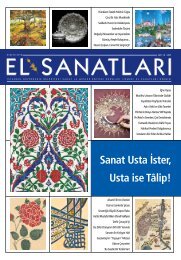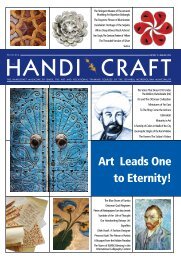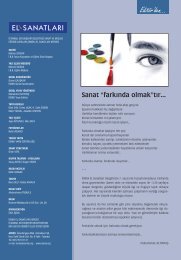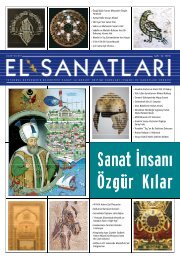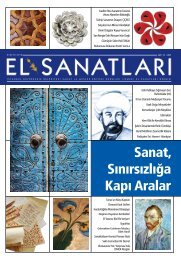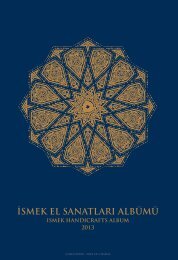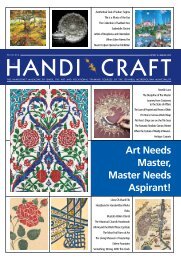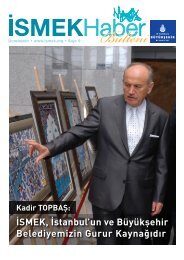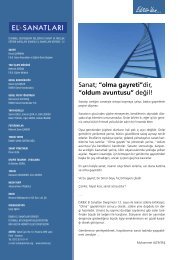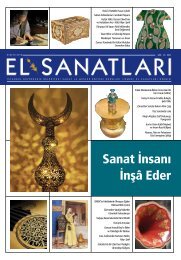Download Link - Ä°SMEK
Download Link - Ä°SMEK
Download Link - Ä°SMEK
Create successful ePaper yourself
Turn your PDF publications into a flip-book with our unique Google optimized e-Paper software.
Sultan Abdulhamid-i Sani on April 17, 1882. Tughras,<br />
the personal signature of the<br />
previous sultans from that<br />
time, took the role of coat<br />
of arm at the same time<br />
which represents dynasty<br />
and government.<br />
Symmetric mysterious<br />
image of Ottoman<br />
coat of arm which reflects<br />
all the elements<br />
of government and embraces<br />
national and spiritual<br />
features together<br />
keeps its secret<br />
due to the anatomical<br />
structure that presents a historical depth. As a<br />
result of widespread use of it that any other<br />
coat of arms had such a chance and being<br />
internalized by folk, it is used not only government<br />
correspondence but also social and daily life.<br />
Tughra emerged from the sign that Oguz Han used<br />
who is one of Oguz Khans. Tughra as a word phrase<br />
has two meaning, the first meaning of it: big predatory<br />
falcon whose two wings are open, tugrul bird.<br />
The other meaning of it: specific symbols which Ottoman<br />
Sultans used instead of signature, augury, Nishani<br />
Hâkânî which is derived from the word “tuğrağ”.<br />
Leather seal with coat of arms<br />
In Anatolian dialect "ğ" is not used at the end of<br />
the word so it changes as tuğra over time. Tugrul<br />
Bey used the first tughra whose shape was beetle<br />
also used as a coat of arm by Kınık Clan and Seljuks<br />
used double-headed tugrul bird as tughra. Anatolian<br />
Seljuks’ curved tughras passed to Ayyubids, with a little<br />
change reached to Mamluks. In Mamluks tughras<br />
whose vertical lines are intense are used instead of<br />
the ones which contain the names of monarch and<br />
his father in curved lines. Anatolian Seljuk Sultans’<br />
names take place with double-headed tugrul bird in<br />
some epigraphs. Tughras are used on coins and correspondence<br />
in Anatolian Seignories. "There is the<br />
oldest tughra image in seignories on Ishak Bey's, the<br />
son of Saruhan Bey, silver coin dated (777H.1374G.)" 1<br />
Tughra in Ottoman Sultans<br />
First tughra in Ottoman Empire is supposed to belonged<br />
Osman Gazi who established the empire at<br />
Söğut and its around. The oldest document with<br />
tughra belongs to Ottoman State takes place in<br />
Orhan Gazi's Çalıca Vakfiye 2 (deed of a pious foundation)<br />
during Osman Gazi's lordship labeled as<br />
"Orhan Sultan" dated 700/10 May, 1301. After his<br />
father's death as the second Ottoman Sultan Orhan<br />
Gazi's tughra is changed as "Orhan bin Osman" in<br />
Mekece Vakfiye which is dated 20 Rebî’ul-evvel 724<br />
(17 March 1324).<br />
Cigarette case with coat of arms<br />
“Bin” is an Arabic origin word meaning<br />
“son”, this expression will also create basis<br />
for the next tughras. The only known document<br />
of Sultan I. Murad with tughra takes<br />
place in a vakfiye dated 1366. In this document<br />
fringes which take place on the right<br />
of letter Elif passed to left. In addition, letter<br />
nun in "Murad Bin Orhan" reaches over<br />
the first fringe from the right side forming<br />
sanjak, so egg section began to take a form<br />
slowly by slowly. In this sultan tughra, tughs'<br />
fringe and sanjak side fluctuate from east to<br />
137



